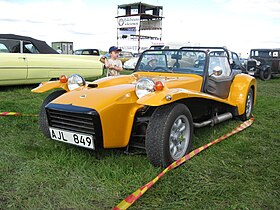Lotus Super Seven
| Lotus Seven | |
|---|---|
 |
|
| Overview | |
| Manufacturer | Lotus Cars |
| Also called | Lotus 7 Lotus Super Seven |
| Production | 1957–1973 |
| Assembly | Hethel, Norfolk, England, United Kingdom, Martínez, Argentina |
| Designer | Colin Chapman |
| Body and chassis | |
| Class | Sports car |
| Body style | roadster |
| Layout | FMR layout |
| Powertrain | |
| Transmission | manual |
| Chronology | |
| Predecessor | Lotus Mark VI |
| Successor | Caterham 7 |
| First generation | |
|---|---|
 |
|
| Overview | |
| Production | 1957–1960 |
| Body and chassis | |
| Related | Lotus Eleven |
| Powertrain | |
| Engine | 1,172 cc (1.2 L) I4 |
| Second generation | |
|---|---|
 |
|
| Overview | |
| Production | 1961–1967 |
| Powertrain | |
| Engine | 1,340 cc (1.3 L) I4 |
| Third generation | |
|---|---|
 |
|
| Overview | |
| Production | 1968–1969 |
| Powertrain | |
| Engine | 1,600 cc (1.6 L) I4 |
| Fourth generation | |
|---|---|
 |
|
| Overview | |
| Production | 1970–August 1973 |
| Powertrain | |
| Engine | 1,600 cc (1.6 L) I4 1,700 cc (103.7 cu in) I4 |
The Lotus Seven is a small, simple, lightweight two-seater open-top sports car produced by the British manufacturer Lotus Cars (initially called Lotus Engineering) between 1957 and 1972.
It was designed by Lotus founder Colin Chapman and has been considered the embodiment of the Lotus philosophy of performance through low weight and simplicity. The original model was highly successful with more than 2,500 cars sold, due to its attraction as a road legal car that could be used for clubman racing.
After Lotus ended production of the Seven, Caterham bought the rights and today Caterham make both kits and fully assembled cars based on the original design.
The Lotus Seven design has spawned a host of imitations on the kit car market, generally called Sevens or sevenesque roadsters.
The Lotus Seven was launched in 1957, after the Lotus Eleven was in limited production. The Seven name was left over from a model that was abandoned by Lotus, which would have been a Riley-engined single-seater that Lotus intended to enter into the Formula Two in 1952 or 1953. However, the car was completed around Chapman's chassis as a sports car by its backers and christened the Clairmonte Special.
Externally similar to Chapman's first series-produced Lotus Mark VI, but with a tubular frame similar to the Lotus Eleven, the Seven was powered by a 40 bhp (30 kW; 41 PS) Ford Side-valve 1,172 cc inline-four engine. It was mainly for road use and lower budget club racing on short tracks (750 motor club).
The Lotus Seven S2 followed in 1960 and was supplemented by the Lotus Super Seven S2 from 1961. The Super Seven initially used the larger Cosworth modified 1340cc Ford Classic engine and later examples were fitted with 1498cc or 1599cc engines. The Seven S3 was released in 1968. In 1970, Lotus radically changed the shape of the car to create the slightly more conventional sized Series 4 (S4), with a squarer fibreglass shell replacing most of the aluminium bodywork. It also offered some "luxuries" as standard, such as an internal heater matrix.
...
Wikipedia
